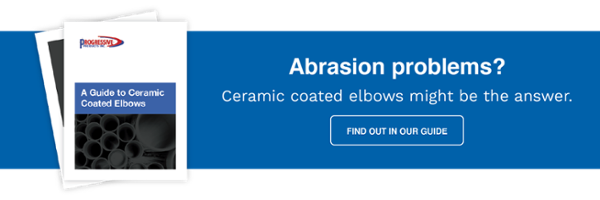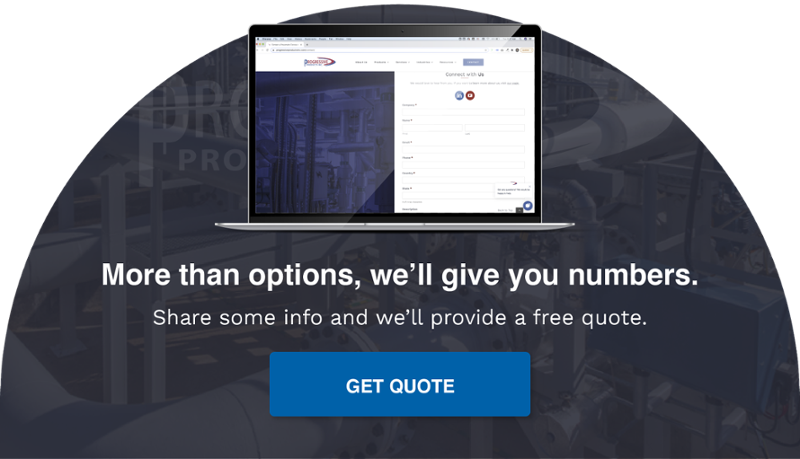People who manage pneumatic conveying systems often ask us how they can figure out what’s causing wear to the elbows in their system – and in turn, how they can minimize this wear. It’s a great question, and one which has various answers because there are different things which could be causing the abrasion.
While a wear solution can be unique to every application, there are some basic things to look out for that can help solve your elbow wear problem. They’re all in the checklist below, and by taking the time to work through this list and gather the information you need – even if you can’t fix the problem yourself – you'll help someone knowledgeable in wear and abrasion resistant solutions to find the best product for your system, and the one that offers the most value.
While there's no guarantee these solutions will instantly solve your problem (as you will always experience some wear), they should help you find a better elbow for your system than the one you currently use.
The Elbow Wear Checklist for Solving Abrasion Problems
1.) The material your conveying line is made from
Changing the material your conveying line is made from can be one of the easiest solutions to excessive wear if it’s made from aluminum. As aluminum is a soft material, if you're running an abrasive material through aluminum conveying lines, you can extend your elbow life simply by moving to a carbon or stainless steel elbow.
2.) The centerline radius of your elbows
If you’re conveying an abrasive product and your system uses short radius elbows, you will probably be experiencing a lot of wear. Check whether you're using weld elbows or tight radius bends and if you are, it might be best to change to a long radius elbow where the centerline radius is 10 times outside diameter, or change to a dead-end tee.
3.) The placement of the elbow in your conveying line
Velocity is one of the main causes of abrasive wear to elbows in pneumatic conveying systems. Depending on the type of material being conveyed, the impact alone can be what is causing wear. If you’re experiencing wear at the end of a long conveying line run, it’s likely this particular elbow is the only elbow in your system that needs to be addressed. If this is the case, you may only need to replace that particular elbow with a better abrasion resistant solution and leave the others in the system as they are.
4.) The current average lifespan of your elbows
This is one of the most important things to find out about the elbows in your conveying system. If you know the lifespan of your elbows as well as the material, centerline radius, and placement, it can help determine the best solution to your wear problem. Perhaps your problem can't simply be solved by using longer elbows or switching to stainless steel. In that case, you may need a specialty elbow. There are many different kinds of specialty elbows, so knowing the lifespan helps determine which solution would be best for your system. If you’re already using an abrasion-resistant elbow and you’re still not getting the results you need, knowing the lifespan will also help to determine what different or more optimized solution could be used.
5.) The product you convey in your system
This is another critical consideration. The product you convey will guide which solution(s) can be used to help reduce wear. You also need to consider other requirements, such as food-grade specifications. Additionally, if you don’t know the lifespan of your elbows, considering the product can steer you toward the best possible solution by using existing field data.
6.) The temperature you convey product at
While knowing the temperature you convey your product at won't necessarily help you solve your abrasion-related problem, it will eliminate any solutions that have a temperature threshold below what’s best for your application.
How Have you Tried to Solve your Elbow Wear Problems in the Past?
Sometimes knowing what solutions to your elbow wear problems haven’t worked in the past gives a good indication of what might work better in the future. A previous solution failure provides some field data on application characteristics you may not otherwise think about. An example could be that you have previously switched to using a reinforced elbow which prevented wear in one area of your system, only to start experiencing wear somewhere else. It’s a good idea to keep track of how all the previous solutions you’ve tried have worked as that will give you data to use when you’re looking for a more permanent solution.
It goes without saying that trading out a wear problem for a different type of problem altogether isn't acceptable, so it’s worth considering other factors when you’re selecting an elbow solution. This could be things like:
- Whether you’re conveying food ingredients
- If your application is corrosive
- If the environment is corrosive
- If you are concerned about contamination
Considering the basic characteristics of your pneumatic conveying system can be immensely helpful in making common-sense decisions about reducing wear for the long-term. Even when you're not an expert in pneumatic conveying yourself, having this information and knowledge will help you find the right solution for your elbow wear problem.
At Progressive Products, we can help you identify the reasons you’re experiencing elbow wear, and advise the right solution for your system. Contact us today and we’ll find the right solution for you.



